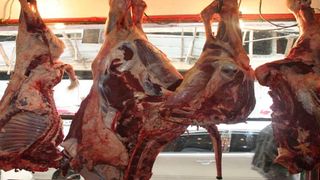Breaking News: At least 10 feared to have drowned in Makueni river

Meat on display in a butchery.
| File | Nation Media GroupNews
Premium
Why a kilo of meat will cost a fortune
What you need to know:
- Naivasha sub-county veterinary officer Miriam Nakeel said that the rising cost of animal feeds had taken a toll on farmers.
- Feed prices were increased two weeks ago, with a 50kg bag of broiler feed rising to at least Sh300.
Less than two months ago, livestock farmer Silvanus Kamamia sold a 20kg goat for Sh6,000, but with the current drought, the price has shot to Sh9,000.
Mr Kamamia, from Naivasha-Ndabibi, said farmers have had to lease grazing fields, with one acre of dry maize stalks going for Sh2,000.
Still, the herding fields are dwindling, forcing the nomadic farmers to cough up more money to feed their animals, with the extra costs being passed to consumers.
He has had to significantly reduce his herd to cope with the higher costs, which threaten to cripple the livelihoods of pastoralists.
Before the prices of feeds rose, Mr Kamamia was the proud owner of more than 500 goats and sheep and about 150 cattle.
“I now have about 200 goats and sheep and about 60 cattle. Livestock farming is no longer an income-generating venture. We are struggling for survival,” he told the Nation.
He cited the prices of lick salt, saying a bag used to cost Sh4,000 and has risen to Sh5,000. “With a big herd, the enterprise is unprofitable,” Mr Kamamia added.
Prices of feeds
Just like many other livestock farmers in the remote area, he is at sixes and sevens, saying that if the government fails to control the prices of feeds he will abandon his herding business.
Mr Kamamia explained that farmers have had to raise the prices of their animals because the costs of feeds, grazing fields and lick salt had skyrocketed, forcing them to adjust their prices.
“A 100kg bull used to cost Sh60,000 but we are now selling at Sh70,000,” he said.
He also said that the highly contagious viral foot and mouth disease was killing their stock, further compounding the situation.
“I am not alone in this. A majority of livestock farmers are also in the same predicament and if the situation does not improve, we might decide to abandon the venture altogether,” he said.
He said many community members who survived on cattle rearing face a bleak future.
“I appeal to the national government to come up with practical solutions that will cushion livestock and chicken farmers, especially those in rural areas,” Mr Kamamia said.
Pain of farmers
Naivasha sub-county veterinary officer Miriam Nakeel said that the rising cost of animal feeds had taken a toll on farmers, further pushing up the prices of slaughter animals.
“The most affected are pig farmers, as most of the ingredients used in making feeds are imported from neighbouring countries,” she said.
The country government, she said, could do little to lessen the pain of farmers and the issue lay squarely on the national government.
Feed prices were increased two weeks ago, with a 50kg bag of broiler feed rising to at least Sh300.
Most chicken farmers are now opting to sell their layer stock, with the prices of eggs remaining constant at Sh310 per tray in a competitive market.
Chicken farmer Virginia Gichuhi said a 50 kg bag of starter feed was selling for Sh3,285, which has now shot to Sh3,985 in the past two weeks
“The viable option seems to be to ditch the trade,” she said.
Ms Gichuhi said the price of a day-old chick had also gone up from Sh80 to 85, further signalling the tough times that farmers are facing.
Hotel owners are declining to purchase eggs at higher prices, fearing they might have to pass the cost to consumers.
Naivasha feed stockist George Gichimu said farmers were shying away from buying the products, saying the business had plummeted.
“We are experiencing depressed sales because a majority of our major customers who are chicken farmers have opted out of the business, claiming they were making losses,” he said.
The prices of kienyeji feeds, he said, had increased by Sh200, further affecting the livelihoods of most middle-income earners.
The trader is now cautious when buying stock, unlike in the past when a steady flow of faithful clients flocked to his shop in the town centre.
Earlier this week, butchery operators declined to purchase goat meat after sellers increased prices by more than Sh100. The operators protested over the hiked prices at the Naivasha abattoir.
Struggling financially
Butchery operator Thomas Mulwa said it had become complicated buying goats and sheep from middlemen owing to the latest price increase.
“We usually purchase our slaughter animals directly from farmers, unlike those who rely on middlemen, but if the situation persists, we shall also be forced to increase the prices of meat,” he said.
His outlet is among the most popular nyama choma eating points in Naivasha but, during the interview, it was obvious the number of customers had decreased.
“Customers are struggling financially and increasing the prices will only spell doom for the business. To be precise, we are in a catch-22 situation,” Mr Mulwa said.
He warned that if the situation fails to improve, they will have to increase the prices of a kilo of meat from the current Sh570.
The Kenya Meteorological Department said the onset of seasonal rains was likely to be delayed and would be marked by intermittent dry spells, especially in eastern Kenya.
In the highlands west of the Rift Valley, rainfall is likely to start in September, with the onset for the rest of the country expected in the third week of October to the second week of November.





